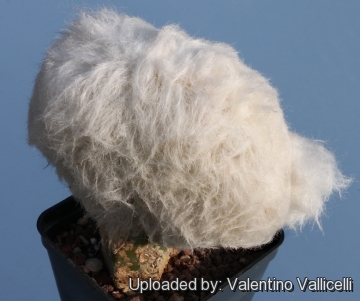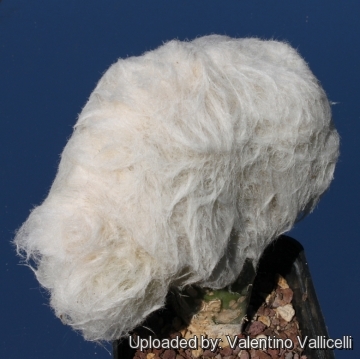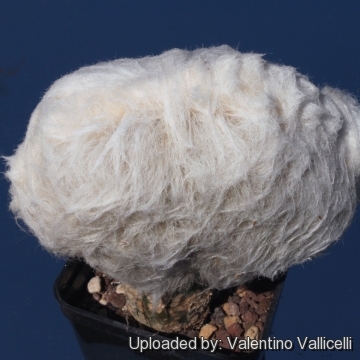
Espostoa huanucoensis f. cristata Photo by: Valentino Vallicelli
Origin and Habitat: Garden origin (Nursery produced cultivar)
Synonyms:
See all synonyms of Espostoa huanucoensis
Description: Espostoa huanucoensisSN|12852]]SN|12852]] (a.k.a. Peruvian Old Man Cactus ) is a shrubby, tubular growing cactus well adapted to high altitudes. The most striking feature of this species is the warm “woolly coat” it possesses, which serve to protect it from the harsh sun common to its native habitat. The crest form Espostoa huanucoensisSN|12852]]SN|12852]] f. cristata - despite to its beauty - is still very rare and sought after by collectors, for its unique features.
Stem: Fan-shaped, erect or diverging, green, 6-8 cm in width.
Ribs: Vertical, low rounded, separated by linear furrows, 5-7 mm high.
Areoles: With yellowish brown felt almost concealed by white or yellowish hairs and spines. The hairs are neatly brushed, cunningly concealing the sharp spines that are a trap to the unwary.
Spines: All radials 30-40, bright golden yellow, needle-like, 0,5-1 cm long.
Lateral cephalia (flower producing structure): Covering 5-8 ribs, 1-2 m long, with white hairs 5-7 mm long.
*Flowers: White, nocturnal, funnelform, nearly hidden by the wool, 5,5-7 cm long.
Blooming season: Late spring, early summer.
Fruits: Top shaped, near spherical 2-3,5 cm long, green or purplish-red, very juicy, sweet and edible.
Seeds: Very small, black and shining.
Bibliography: Major references and further lectures
1) James Cullen, Sabina G. Knees, H. Suzanne Cubey “The European Garden Flora Flowering Plants: A Manual for the Identification of Plants Cultivated in Europe, Both Out-of-Doors and Under Glass” Cambridge University Press, 11/Aug./2011
2) David Hunt, Nigel Taylor “The New Cactus Lexicon” DH Books, 2006
3) Edward F. Anderson “The Cactus Family” Timber Press, 2001
 Espostoa huanucoensis f. cristata Photo by: Valentino Vallicelli
Espostoa huanucoensis f. cristata Photo by: Valentino Vallicelli Espostoa huanucoensis f. cristata Photo by: Valentino Vallicelli
Espostoa huanucoensis f. cristata Photo by: Valentino Vallicelli Espostoa huanucoensis f. cristata Photo by: Valentino Vallicelli
Espostoa huanucoensis f. cristata Photo by: Valentino VallicelliSend a photo of this plant.The gallery now contains thousands of pictures, however it is possible to do even more. We are, of course, seeking photos of species not yet shown in the gallery but not only that, we are also looking for better pictures than those already present.
Read More... Cultivation and Propagation: Espostoa huanucoensisSN|12852]]SN|12852]] f. cristata is not too difficult in a greenhouse, although grows quite slowly. It is usually seen as a grafted plant but can grow on its own roots too.
Soil: Use a mineral well permeable soil with little organic matter (peat, humus).
Exposure: They need a good amount of light shade to full sun this help to keep the plants healthy, although slow growth.
Watering: Water sparingly from March till October (weekly during summertime, if the weather is sunny enough), with a little fertilizer added. Less or no water during cold winter months, or when night temperatures remain below 10° to prevent root loss. It is sensitive to overwatering (rot prone).
Fertilization: Feeding may not be necessary at all if the compost is fresh then, feed in summer only if the plant hasn't been repotted recently. Do not feed the plants from September onwards as this can cause lush growth which can be fatal during the darker cold months.
Hardiness: Keep perfectly dry in winter at temperatures from 5 to 15 degrees centigrade. (but it is relatively cold resistant and hardy to -5° C, or possibly colder for short periods) In the rest period no high atmospheric humidity!! (Temperature Zone: USDA 9-11)
Crested growth: Unlike 'monstrose' varieties of plants, where the variation from normal growth is due to genetic mutation, crested growth can occur on normal plants. Sometimes it's due to variances in light intensity, or damage, but generally the causes are unknown. A crested plant may have some areas growing normally, and a cresting plant that looks like a brain, may revert to normal growth for no apparent reason. If you have any of the crested part left you need to remove the normal growth and leave the crested part behind this will need to be done regularly.
Propagation: Grafting or cuttings. Plants are usually grafted onto column-shaped cacti but proved to be able to produce their own roots if degrafted. Cuttings will take root in a minimum temperature of 20° C (but better in hot weather). Cuttings of healthy shoots can be taken in the spring and summer. Cut the stem with a sharp, sterile knife, leave the cutting in a warm, dry place for a week or weeks (depending on how thick the cutting is) until a callus forms over the wound. Once the callus forms, the cutting may be inserted in a container filled with firmed cactus potting mix topped with a surface layer of coarse grit. They should be placed in the coarse grit only; this prevents the cut end from becoming too wet and allows the roots to penetrate the rich compost underneath. The cuttings should root in 2 to 6 weeks. Large crested piece must be placed on the soil surface without burying the plant base down in the soil.













